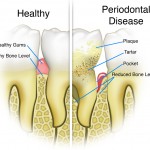
Bone destruction as a result of periodontal disease in multi-rooted teeth can reach the point of root separation. This furcation involvement (FI) has been reported in between 30-50% of patients with periodontitis. Furcation defects are generally classified into degree I, II or III based on the horizontal component of the bony defect and teeth with furcation involvement are considered to have a poorer prognosis.
The aim of this review was to investigate risk of tooth loss in molars with furcation involvement (FI) based on initial diagnosis.
Methods
Searches were conducted in the Medline, Embase, LILACS and Cochrane Library databases supplements by hand searches of the Journal of Clinical Periodontology, Journal of Dental Research and Journal of Periodontology. Longitudinal retrospective or prospective human studies in patients with chronic periodontitis (CP) presenting data on furcation diagnosis and tooth loss with at least 3 years follow up were considered. Studies of aggressive periodontitis (AgP) were excluded.
Two reviewers independently selected studies, abstracted data and assessed study quality. Risk of bias was assessed using the Newcastle-Ottawa Scale. The primary outcome was tooth loss. The relative risk was calculated and random effects meta-analyses performed.
Results
- 21 studies (16 retrospective, 5 prospective) were included.
- Sample size varies from 9-600.
- A majority were conducted in the USA (11), 6 in Germany, 2 in Sweden and I each in Switzerland and Italy.
- Patient reported outcomes were note reported by any study.
- The relative risk of tooth loss during maintenance therapy attributable to FI was
- 1.46 (95%CI; 0.99–2.15, p = 0.06) for studies up to 10 years (3 studies)
- 2.21 (95%CI; 1.79–2.74, p < 0.0001) for studies with a 10-15 years follow up (3 studies).
- A gradual increase in the risk of tooth loss was observed for molars with degree II and III FI.
Conclusions
The authors concluded
The presence of FI approximately doubles the risk of tooth loss for molars maintained in supportive periodontal therapy for up to 10–15 years. However, most molars, even with grade III FI respond well to periodontal therapy, suggesting that every effort should be made to maintain these teeth when possible. Long-term studies reporting patient-reported outcomes are needed to substantiate this conclusion.
Comments
The findings of this review suggest that most molars affected by FI respond well periodontal treatment with around 30% of molars being lost over 5-15 years. This would suggest that maintaining teeth with FI is an appropriate strategy. The review provides an estimate of the rate of tooth loss for teeth with FI in patients having periodontal treatment but we do not know the rate of tooth loss in patients not having periodontal treatment.
While a large number of studies have been included in this review a majority are retrospective studies, which have a greater potential for bias. The authors also highlight that there may be the possibility for publication bias. The available data also does not allow for the reviewers to take into account the effects of clustering. As the authors indicate these points mean that the findings of the review should be interpreted cautiously.
Links
Primary paper
Nibali L, Zavattini A, Nagata K, Di Iorio A, Lin G-H, Needleman I, Donos N. Tooth loss in molars with and without furcation involvement – a systematic review and meta-analysis. J Clin Periodontol 2016; doi: 10.1111/jcpe.12497.
Other references
Dental Elf – 7th Jul 2015 – Periodontal surgery for furcation defects

Risk of tooth loss in periodontitis may double with furcation involvement https://t.co/yGsaGU58lT
Furcation involvement may double risk of tooth loss in periodontitis https://t.co/yGsaGU58lT
Risk of tooth loss in periodontitis may double with furcation involvement https://t.co/TDjv43fTuI
Periodontal disease-molar tooth loss is increased with furcation involvement https://t.co/yGsaGU58lT
Molar tooth loss may increase by 50% with furcation involvement https://t.co/yGsaGU58lT
50% increase in molar tooth loss with furcation involvement suggests review https://t.co/yGsaGU58lT
Don’t miss- Furcation involvement may double risk of tooth loss in periodontitis https://t.co/yGsaGU58lT